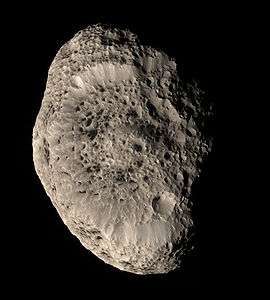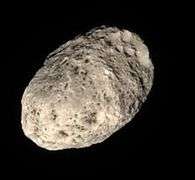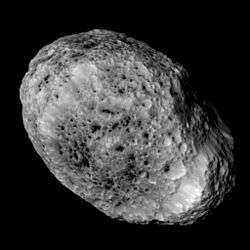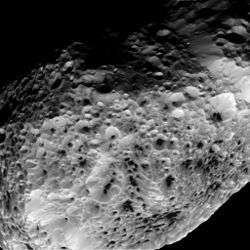Hyperion (moon)
 | |
| Discovery | |
|---|---|
| Discovered by | |
| Discovery date | 16 September 1848 |
| Designations | |
| Saturn VII | |
| Adjectives | Hyperionian |
| Orbital characteristics | |
| 1,481,009 km (920,256 mi)[lower-alpha 1] | |
| Eccentricity | 0.1230061[1] |
| 21.276 d | |
| Inclination | 0.43° (to Saturn's equator)[2][3] |
| Satellite of | Saturn |
| Physical characteristics | |
| Dimensions | 360.2 km × 266 km × 205.4 km (223.8 mi × 165.3 mi × 127.6 mi)[4] |
Mean radius | 135 km (84 mi)[4] |
| Mass | (5.6199±0.05)×1018 kg[4] |
Mean density | 0.544±0.050 g/cm3[4] |
| 0.017–0.021 m/s2 depending on location[4] | |
| 45–99 m/s depending on location.[5] | |
| chaotic | |
| variable | |
| Albedo | 0.3[6] |
| Temperature | 93 K (−180 C)[7] |
| 14.1[8] | |
|
| |
Hyperion (/haɪˈpɪəriən/;[lower-alpha 2] Greek: Ὑπερίων), also known as Saturn VII (7), is a moon of Saturn discovered by William Cranch Bond, George Phillips Bond and William Lassell in 1848. It is distinguished by its irregular shape, its chaotic rotation, and its unexplained sponge-like appearance. It was the first non-round moon to be discovered.
Name
The moon is named after Hyperion, the Titan god of watchfulness and observation – the elder brother of Cronus, the Greek equivalent of Saturn – in Greek mythology. It is also designated Saturn VII. The adjectival form of the name is Hyperionian.
Hyperion's discovery came shortly after John Herschel had suggested names for the seven previously-known satellites of Saturn in his 1847 publication Results of Astronomical Observations made at the Cape of Good Hope.[9] William Lassell, who saw Hyperion two days after William Bond, had already endorsed Herschel's naming scheme and suggested the name Hyperion in accordance with it.[10] He also beat Bond to publication.[11]
Physical characteristics
Shape
Hyperion is one of the largest bodies known to be highly irregularly shaped (non-ellipsoidal, i.e. not in hydrostatic equilibrium) in the Solar System.[lower-alpha 3] The only larger moon known to be irregular in shape is Neptune's moon Proteus. Hyperion has about 15% of the mass of Mimas, the least massive known ellipsoidal body. The largest crater on Hyperion is approximately 121.57 km (75.54 mi) in diameter and 10.2 km (6.3 mi) deep. A possible explanation for the irregular shape is that Hyperion is a fragment of a larger body that was broken up by a large impact in the distant past.[12] A proto-Hyperion could have been 350–1,000 km (220–620 mi) in diameter.[13] Over about 1,000 years, ejecta from a presumed Hyperion breakup would have impacted Titan at low speeds, building up volatiles in the atmosphere of Titan.[13]

Composition
Like most of Saturn's moons, Hyperion's low density indicates that it is composed largely of water ice with only a small amount of rock. It is thought that Hyperion may be similar to a loosely accreted pile of rubble in its physical composition. However, unlike most of Saturn's moons, Hyperion has a low albedo (0.2–0.3), indicating that it is covered by at least a thin layer of dark material. This may be material from Phoebe (which is much darker) that got past Iapetus. Hyperion is redder than Phoebe and closely matches the color of the dark material on Iapetus.
Hyperion has a porosity of about 0.46.[5]
Surface features
Voyager 2 passed through the Saturn system, but photographed Hyperion only from a distance. It discerned individual craters and an enormous ridge, but was not able to make out the texture of Hyperion's surface. Early images from the Cassini orbiter suggested an unusual appearance, but it was not until Cassini's first targeted flyby of Hyperion on 25 September 2005 that Hyperion's oddness was revealed in full.
Hyperion's surface is covered with deep, sharp-edged craters that give it the appearance of a giant sponge. Dark material fills the bottom of each crater. The reddish substance contains long chains of carbon and hydrogen and appears very similar to material found on other Saturnian satellites, most notably Iapetus. Scientists attribute Hyperion's unusual, sponge-like appearance to the fact that it has an unusually low density for such a large object. Its low density makes Hyperion quite porous, with a weak surface gravity. These characteristics mean impactors tend to compress the surface, rather than excavating it, and most material that is blown off the surface never returns.[14]
The latest analyses of data obtained by Cassini during its flybys of Hyperion in 2005 and 2006 show that about 40 percent of it is empty space. It was suggested in July 2007 that this porosity allows craters to remain nearly unchanged over the eons. The new analyses also confirmed that Hyperion is composed mostly of water ice with very little rock.[15]
Rotation

The Voyager 2 images and subsequent ground-based photometry indicated that Hyperion's rotation is chaotic, that is, its axis of rotation wobbles so much that its orientation in space is unpredictable. Its Lyapunov time is around 30 days.[16] Hyperion, together with Pluto's moons Nix and Hydra,[17][18] is among only a few moons in the Solar System known to rotate chaotically, although it is expected to be common in binary asteroids.[19] It is also the only regular planetary natural satellite in the Solar System known not to be tidally locked.
Hyperion is unique among the large moons in that it is very irregularly shaped, has a fairly eccentric orbit, and is near a much larger moon, Titan. These factors combine to restrict the set of conditions under which a stable rotation is possible. The 3:4 orbital resonance between Titan and Hyperion may also make a chaotic rotation more likely. The fact that its rotation is not locked probably accounts for the relative uniformity of Hyperion's surface, in contrast to many of Saturn's other moons, which have contrasting trailing and leading hemispheres.[20]
Exploration
Hyperion has been imaged several times from moderate distances by the Cassini orbiter. The first close targeted flyby occurred at a distance of 500 km (310 mi) on 26 September 2005.[14] Cassini made another two close approaches to Hyperion on 25 August 2011 and on 16 September 2011, when it passed at 58,000 km (36,000 mi).[21] Cassini's latest flyby was on 31 May 2015 at a distance of about 34,000 km (21,000 mi).[14]

from 37,000 km (23,000 mi)
(31 May 2015).

from 38,000 km (24,000 mi)
(31 May 2015).
See also
Notes
- ↑ Computed from period, using the IAU-MPC NSES µ value.
- ↑ In US dictionary transcription, US dict: hī·pēr′·ē·ən.
- ↑ There are about ten asteroids and an unknown number of irregular Trans-Neptunian Objects larger than Hyperion.
References
- ↑ Pluto Project pseudo-MPEC for Saturn VII
- ↑ NASA's Solar System Exploration: Saturn: Moons: Hyperion: Facts & Figures
- ↑ MIRA's Field Trips to the Stars Internet Education Program: Saturn
- 1 2 3 4 5 Thomas, P. C. (July 2010). "Sizes, shapes, and derived properties of the saturnian satellites after the Cassini nominal mission" (PDF). Icarus. 208 (1): 395–401. Bibcode:2010Icar..208..395T. doi:10.1016/j.icarus.2010.01.025.
- 1 2 Thomas, P.C.; Armstrong, J. W.; Asmar, S. W.; Burns, J. A.; Denk, T.; Giese, B.; Helfenstein, P.; Iess, L.; et al. (2007). "Hyperion's Sponge-like Appearance". Nature. 448 (7149): 50–56. Bibcode:2007Natur.448...50T. doi:10.1038/nature05779. PMID 17611535.
- ↑ D.R. Williams (18 September 2006). "Saturnian Satellite Fact Sheet". NASA. Retrieved 2007-11-04.
- ↑ "About Saturn & Its Moons: Moons – Hyperion". Cassini @ JPL/NASA. Retrieved 2011-01-30.
- ↑ Observatorio ARVAL (April 15, 2007). "Classic Satellites of the Solar System". Observatorio ARVAL. Retrieved 2011-12-17.
- ↑ Lassell, W. (14 January 1848). "Observations of satellites of Saturn". Monthly Notices of the Royal Astronomical Society. 8 (3): 42–43. Bibcode:1848MNRAS...8...42L. doi:10.1093/mnras/8.3.42. Retrieved 2011-12-18.
- ↑ W. Lassell (1848). "Discovery of a New Satellite of Saturn". Monthly Notices of the Royal Astronomical Society. 8 (9): 195–197. Bibcode:1848MNRAS...8..195L. doi:10.1093/mnras/8.9.195a.
- ↑ Bond, W.C. (1848). "Discovery of a new satellite of Saturn". Monthly Notices of the Royal Astronomical Society. 9 (1): 1–2. Bibcode:1848MNRAS...9....1B. doi:10.1093/mnras/9.1.1.
- ↑ R.A.J. Matthews (1992). "The Darkening of Iapetus and the Origin of Hyperion". Quarterly Journal of the Royal Astronomical Society. 33: 253–258. Bibcode:1992QJRAS..33..253M.
- 1 2 Farinella, P.; Marzari, F.; Matteoli, S. (1997). "The Disruption of Hyperion and the Origin of Titan's Atmosphere". Astronomical Journal. 113 (2): 2312–2316. Bibcode:1997AJ....113.2312F. doi:10.1086/118441.
- 1 2 3 "Cassini Prepares for Last Up-close Look at Hyperion". Jet Propulsion Laboratory. 28 May 2015. Retrieved 2015-05-29.
- ↑ "Key to Giant Space Sponge Revealed". Space.com. Retrieved October 26, 2007.
- ↑ Tarnopolski, Mariusz (9 Dec 2014). "Nonlinear time series analysis of Hyperion's rotation: photometric observations and numerical simulations".
- ↑ M. R. Showalter, D. P. Hamilton (Jun 2015). "Resonant interactions and chaotic rotation of Pluto's small moons". Nature. 522: 45–49. doi:10.1038/nature14469. PMID 26040889.
- ↑ Kenneth Chang (2015-06-03). "Astronomers Describe Chaotic Dance of Pluto's Moons". New York Times.
- ↑ Nadoushan, M. J.; Assadian, N. (2015). "Widespread chaos in rotation of the secondary asteroid in a binary system". Nonlinear Dynamics. Springer. 81: 1–12. doi:10.1007/s11071-015-2123-0.
- ↑ Wisdom, J.; Peale, S.J.; Mignard, F. (1984). "The chaotic rotation of Hyperion". Icarus. 58 (2): 137–152. Bibcode:1984Icar...58..137W. doi:10.1016/0019-1035(84)90032-0.
- ↑ "Saturn's Odd Pockmarked Moon Revealed in New Photos". Space.com. Retrieved 31 August 2011.
External links
| Wikimedia Commons has media related to Hyperion. |
- Cassini mission Hyperion page
- Hyperion Profile at NASA's Solar System Exploration site
- The Planetary Society: Hyperion
- NASA: Saturn's Hyperion, A Moon With Odd Craters
- Cassini images of Hyperion
- Images of Hyperion at JPL's Planetary Photojournal
- Hyperion nomenclature from the USGS planetary nomenclature page
